
The ensign is a maritime flag that is used for the national identification of a ship.[1] The ensign is the largest flag, generally flown at the stern (rear) of the ship while in port. In ports, depending on the ship's origin, it is sometimes identical with a jack on the bow of the ship. Jacks are more common on warships than on merchant ships.
Etymology
The Middle English ensign is derived from the Latin word insignia.
Vexillology
In vexillology an ensign is differentiated between a naval ensign (war ensign) and civil ensign (merchant), which both are the original expressions of the national flag.[2]
However, in the United Kingdom, Germany and Netherlands a separation between State and Armed ships on the one hand, and unarmed and private vessels was made earlier than in other Nations, see British ensign.
Vexillologists distinguish three varieties of a national flag when used as an ensign:
- A state ensign or government ensign (usage symbol
 ) is worn by government vessels of official government agencies or civilian equipped auxiliary ships.
) is worn by government vessels of official government agencies or civilian equipped auxiliary ships.
- A naval ensign (usage symbol
 ) is used by a country's navy as a war flag for military ships, which are enlisted as such.[3] War ensigns do not mean that the country is at war. It is about the military use. They fall under the law of war and United Nations Convention on the Law of the Sea. Large versions of naval ensigns called battle ensigns are used when a warship goes into battle. The ensign differs from the jack, which is flown from a jackstaff at the bow of a vessel additionally, if they are at the port.
) is used by a country's navy as a war flag for military ships, which are enlisted as such.[3] War ensigns do not mean that the country is at war. It is about the military use. They fall under the law of war and United Nations Convention on the Law of the Sea. Large versions of naval ensigns called battle ensigns are used when a warship goes into battle. The ensign differs from the jack, which is flown from a jackstaff at the bow of a vessel additionally, if they are at the port.
- A civil ensign (usage symbol
 ) is worn by merchant and pleasure vessels. The merchant maritime flag or civil ensign is therefore the specific flag for the Merchant navy of a country, unless the (private) owners are authorized to use another. The commercial flag was created to give these private individuals the opportunity to declare their nationality. Some countries have a specific yacht ensign for recreational boats without declared cargo, which differs from the regular ensign and have a specific law. Merchant flags can only be flown by ships that are not ships of war, ships of state, auxiliary ships or yachts. The special feature here is that a ship does not represent an extraterritorial area, but belongs to a private person or similar and does not represent the state itself. This means that the use of the national or even state flag is normally forbidden.
) is worn by merchant and pleasure vessels. The merchant maritime flag or civil ensign is therefore the specific flag for the Merchant navy of a country, unless the (private) owners are authorized to use another. The commercial flag was created to give these private individuals the opportunity to declare their nationality. Some countries have a specific yacht ensign for recreational boats without declared cargo, which differs from the regular ensign and have a specific law. Merchant flags can only be flown by ships that are not ships of war, ships of state, auxiliary ships or yachts. The special feature here is that a ship does not represent an extraterritorial area, but belongs to a private person or similar and does not represent the state itself. This means that the use of the national or even state flag is normally forbidden.
Today, some countries like the United States and France still use just one flag and also as a jack, while lacking special cantons and transparent identification. All ships of the seagoing services of the United States Government with the exception of the United States Coast Guard fly the national flag as their ensign, although the ships of some agencies also fly an agency flag as a 'distinctive mark'.
However, further countries like Ukraine, Italy, Russia, South Africa, Australia, New Zealand and Japan use different ensigns. Such are strictly regulated and indicate if the vessel is a warship, a merchant ship, a ship under contract to carry mail, or a yacht, for example.
Several Commonwealth countries' national flags had their origin in the ensigns of their original colonising power, the United Kingdom. Most notable of these national flags are those of Australia, New Zealand, and several smaller island nations. It is also very likely that the Grand Union Flag from which the flag of the United States developed was strongly influenced by the British Red Ensign or the flag of the (British controlled) East India Company.
Usage
In nautical use, any boat uses a specific flag of a specific Nation to indicate its organizational membership. The ensign is flown on a ship for that reason.[2] The flag signifies the home port of the ship owner and that his tax is paid there for his income made with the ship. Flagging out always means that the relevant laws of the country apply on the ship like employment contracts, safety, stamp duty or value-added taxes.
In most countries, especially in Europe and the countries of the Commonwealth of Nations, it is common for the ensign to display additional information as well. For example, whether it is a civil, state or military flag.
Ensigns are usually at the stern flagstaff when in port, and may be shifted to a gaff (if available) or mast amidships when the ship is under way, becoming known as a steaming ensign.
A boat flag is also often used as guest country flag and is flown on the boat when navigating in foreign waters or entering another country's port.
Air ensigns
With the creation of independent air forces and the growth in civil aviation in the first half of the 20th century, a range of distinguishing flags and ensigns were adopted. These may be divided into air force ensigns (often light blue in colour,[4] such as the Royal Air Force Ensign) and civil air ensigns.
Heraldic ensigns
In heraldry, an ensign is the ornament or sign, such as the crown, coronet, or mitre, borne above the charge or arms.[5]
Gallery
 The White Ensign as currently used by Royal Navy vessels
The White Ensign as currently used by Royal Navy vessels The Blue Ensign as currently used for British government vessels
The Blue Ensign as currently used for British government vessels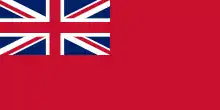 The Red Ensign as currently used for British civilian vessels
The Red Ensign as currently used for British civilian vessels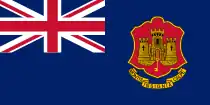

 Royal Air Force Ensign used by the Royal Air Force
Royal Air Force Ensign used by the Royal Air Force





 The Civil Air Ensign as currently used by UK civil aviation establishments
The Civil Air Ensign as currently used by UK civil aviation establishments

.svg.png.webp) Australian national Flag and State Ensign
Australian national Flag and State Ensign
 New Zealand national flag (Māori: Te haki o Aotearoa) and State Ensign
New Zealand national flag (Māori: Te haki o Aotearoa) and State Ensign New Zealand Red Ensign
New Zealand Red Ensign Indian Navy Ensign
Indian Navy Ensign
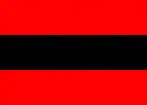 Civil and Naval ensign of Albania
Civil and Naval ensign of Albania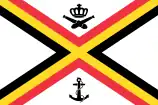 Belgian Navy Ensign
Belgian Navy Ensign Ensign of the Royal Danish Navy
Ensign of the Royal Danish Navy Egyptian Navy Ensign
Egyptian Navy Ensign Finnish yacht club ensign. The circled X represents the club emblem
Finnish yacht club ensign. The circled X represents the club emblem Civil and Naval Ensign of France
Civil and Naval Ensign of France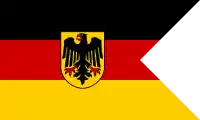 Bundesmarine Ensign
Bundesmarine Ensign Italian Navy Ensign
Italian Navy Ensign Naval ensign of the Imperial Japanese Navy and the Japan Maritime Self-Defense Force
Naval ensign of the Imperial Japanese Navy and the Japan Maritime Self-Defense Force
 Myanmar Navy Ensign
Myanmar Navy Ensign Royal Netherlands Navy Reserve ensign
Royal Netherlands Navy Reserve ensign Nigerian Navy ensign
Nigerian Navy ensign North Korean Navy Ensign
North Korean Navy Ensign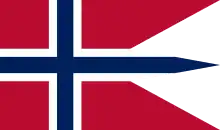 Ensign of the Royal Norwegian Navy
Ensign of the Royal Norwegian Navy Polish Navy Ensign
Polish Navy Ensign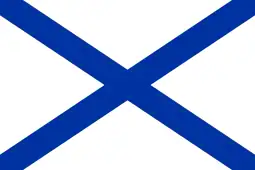
 Naval Ensign of the Royal Saudi Navy
Naval Ensign of the Royal Saudi Navy
 Spanish yacht ensign
Spanish yacht ensign Naval ensign of Sri Lanka
Naval ensign of Sri Lanka Naval ensign of Royal Thai Navy
Naval ensign of Royal Thai Navy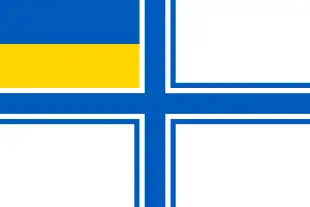 Ukrainian Navy Ensign
Ukrainian Navy Ensign United States Coast Guard ensign
United States Coast Guard ensign Naval ensign of Vietnam
Naval ensign of Vietnam
See also
References
- ↑ "Ensign". Oxford Dictionaries. Archived from the original on July 27, 2012.
- 1 2 Alfred Znamierowski. "Types of flags". The World Encyclopedia of Flags. p. 31.
- ↑ Znamierowski. "Naval ensigns and flags". The World Encyclopedia of Flags. p. 88.
- ↑ Znamierowski. "Air force flags". The World Encyclopedia of Flags. p. 85.
- ↑ Snell, Melissa. "Pimbley's Dictionary of Heraldry". Archived from the original on 2014-07-11. Retrieved 2014-06-15.
Sources
- Znamierowski, Alfred (2002). The world encyclopedia of flags : The definitive guide to international flags, banners, standards and ensigns. London, England: Hermes House. ISBN 1-84309-042-2.
- Kavussanos, Manolis G. (2014). The Option to Change the Flag of a Vessel. SSRN.